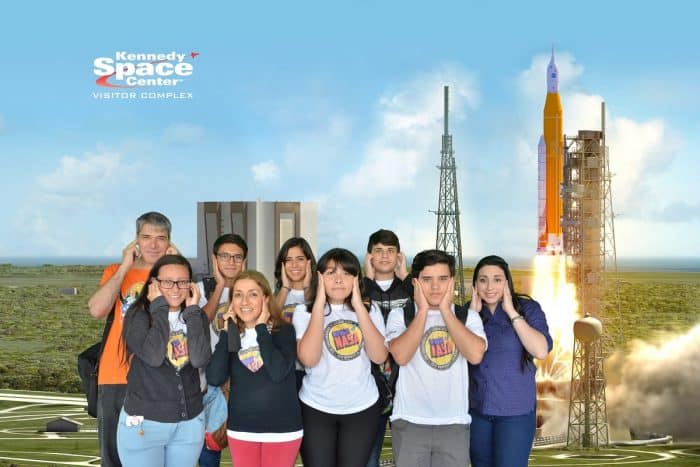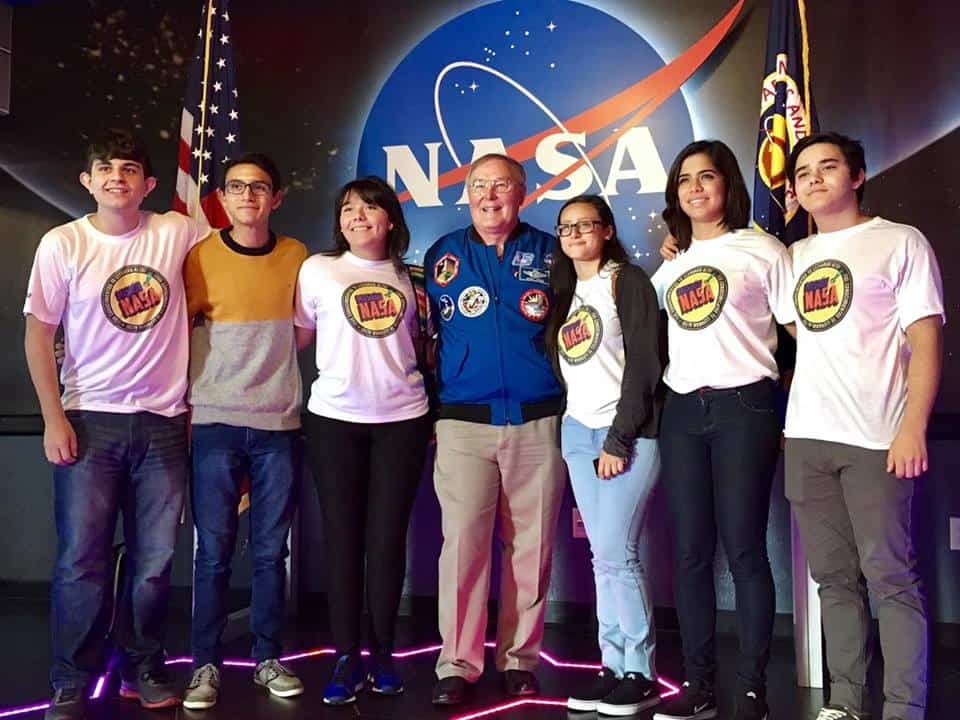See also: Costa Rican students get the surprise of a lifetime – a trip to NASA
“C’mon, let’s go!” Elián Mora shouted with excitement as he raced towards NASA’s Mars Mixed Reality Simulator.
His five companions were close on his heels; only moments before, they had been the first people of the day to enter the Kennedy Space Center. The excitement in the group was visible to anyone who saw them. These were not ordinary tourists making the rounds of Central Florida’s theme parks. Each of these young Costa Ricans, part of a group called Los Lunáticos, had overcome backgrounds full of disadvantages and had beaten the odds though their hard work and determination. Now, with technology developed by the Jet Propulsion Laboratory and Microsoft, they were about to take a walk on planet Mars.
Lunáticos member José André Vega had this to say about his experience on the Red Planet: “I really felt like I was walking on Mars. At that moment I also realized how far we can go if we work together. It was incredible!”
The woman responsible for the group’s trip from Costa Rica to Cape Canaveral, Florida: Costa Rican-born Sandra Cauffman, currently Deputy Director of NASA’s Earth Sciences Division. Cauffman, who herself overcome tremendous challenges growing up in the low income San José district of Hatillo, decided earlier this year that she wanted to include young Costa Ricans in the launch of the GOES-R satellite, NASA’s next generation weather satellite.
Cauffman reached out to Costa Rican contacts and eventually found the Fundación Monge’s Soy Yo program, whose motivated students were a perfect fit. The foundation made the arrangemens, and the trip became a reality for students Daniel Aguilar, Diana Araya, Celinne Cordero, Valeria Salazar, Elián Torres and José Andrá Vega.
Read more: Meet Sandra Cauffman, the Tica directing NASA’s current mission to Mars
Due to the recent impact of Hurricane Matthew, the GOES-R launch was postponed (it eventually took place on Nov. 19), but this setback did not dampen the enthusiasm of the Lunáticos, all of whom were traveling outside of Costa Rica for the first time and had been looking forward to their NASA adventure since March.
“My goal after I retire is to start a Foundation to connect kids to available opportunities,” Cauffman told The Tico Times. “However, before I retire, there is much I can do from my vantage point. What better way to motivate youth than to make these opportunities available to them? As in everything, this was a team effort between Bruce Callow, the Fundación Monge, and NASA, and our desire to motivate kids and to encourage them to follow STEM careers. So yes, it is unusual, very special, and perhaps improbable for one person alone [to achieve], but through networking and teamwork, everything is possible.”
The trip was funded by the Costa Rican nonprofit Fundación Monge’s Soy Cambio program, in which these gifted 17 and 18 year olds are participants. Soy Cambio, whose formal name is the Program of Student Leadership and Employability, works with motivated, low-income students between 15 and 19 years old in Costa Rica and Nicaragua, with plans to expand to Guatemala and Honduras. The foundation provides the students intensive support to help them achieve their academic and professional goals, and training in subjects including English and technology.

The students who went to Florida were selected by the foundation in March for the opportunity proposed by Cauffman because of their excellent academic performance over the last few years. Following their selection, the students participated in a variety of activities to further prepare them for the trip. A few Lunáticos students received special preparation through a Fundación Monge-sponsored JumpStart Costa Rica intensive English camp during school vacation in July.
Judging by the students’ reactions during their tour, all the hard work was well worth it.
“My heart is still pounding. That was an awesome experience,” said Elián Mora as he departed the Space Shuttle Experience. “It really felt like I was in a spaceship! Without a doubt, this is the best day of my life!”
This sentiment was shared by the other members of the team who experienced a range of emotions before entering the simulator, ranging from fear to excitement.
The Lunáticos had been looking forward to visiting the Space Shuttle Simulator since early in the day and were able to test their skills as Space Shuttle astronauts. Hosted by former astronaut and current NASA administrator Charles Bolden, the simulator recreates the effect of travelling 17,500 miles an hour and is as close as non-astronauts can hope to get to actually flying the Space Shuttle – definitely an unforgettable experience.
Next on the agenda was the NASA bus tour to the Saturn V Rocket Center, where the group was transported back to 1968 and viewed the iconic Apollo Flight Center and all of the amazing hardware involved in the Apollo missions.
As we drove by Launch Pad 39A on the way back to the main center where the Apollo astronauts blasted off for the moon and Space X currently carries out its launches, I asked student José André Vega what it was that interested him so much about space, and what he had learned so far that day.
“The mysteries of the universe amaze me, and we have so much more to discover,” he said. “What impressed me most about the Apollo missions is that despite the terrible tragedy when the three astronauts died, they continued with the program until they successfully landed a man on the moon.”
At the end of an intense 11 hours of almost nonstop activities, the Lunáticos were among the last people to exit Kennedy Space Center as the Florida sun slowly set over the historical Rocket Garden, home to some of NASA’s legendary rockets from 1950s and early 1960s. At the end of a day whose recurring theme the students heard over the day was that only by overcoming adversity can one achieve their dreams, the students were already setting their sights on the future.
As we reluctantly made our way to the exits I asked Valeria Salazar, one of the members of the group, how she felt about her day at the Kennedy Space Center.
“For me it was a dream come true,” she said. “It was something that I had wished for since I was a child. My favorite experiences were seeing Mars, meeting astronaut Jerry Ross and seeing the videos about the launch of Apollo. I learned that if you work hard for any dream you can make them come true.”
The Fundación Monge does not accept individual donations, but welcomes suggestions or comments at the email address soycambio@fundacionmonge.com, on their website or through Facebook.
Bruce Callow is a Canadian communications consultant and educator who has resided in Costa Rica since 1992. He was the Communications Officer at the British Embassy for nine years. A member of the Globe International Scientists’ Network, Bruce collaborates with Dr. Franklin Chang Diaz and the Central American Space Association (ACAE), and does space education outreach work on behalf of NASA. Bruce helped coordinate the Lunáticos experience at the Kennedy Space Center with the support of Sandra Cauffman and the Fundación Monge.

